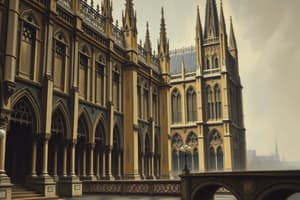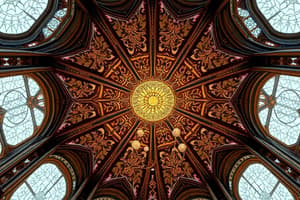Podcast
Questions and Answers
Which of the following best describes a stable structure?
Which of the following best describes a stable structure?
- A structure that changes shape rapidly over time.
- A structure that is easily toppled by external forces.
- A structure that can only withstand forces from one direction.
- A structure that maintains its shape and position over an extended period. (correct)
The center of gravity of an object is the point at which its mass seems to be concentrated.
The center of gravity of an object is the point at which its mass seems to be concentrated.
True (A)
Name four types of structural elements used to support loads.
Name four types of structural elements used to support loads.
Beams, trusses, arches, and domes
When all or part of a structure loses its ability to support a load, it is called a ______.
When all or part of a structure loses its ability to support a load, it is called a ______.
Match the following terms with their descriptions:
Match the following terms with their descriptions:
What was the main cause of the Quebec Bridge disaster, which led to engineers taking an oath?
What was the main cause of the Quebec Bridge disaster, which led to engineers taking an oath?
The Ritual of the Calling of an Engineer includes a public recitation of an oath by new engineers.
The Ritual of the Calling of an Engineer includes a public recitation of an oath by new engineers.
According to the poem 'Modern Machinery', what do machines require to operate effectively?
According to the poem 'Modern Machinery', what do machines require to operate effectively?
The ability of a structure to maintain a balanced position when external forces act on it is defined as ______.
The ability of a structure to maintain a balanced position when external forces act on it is defined as ______.
Match the following:
Match the following:
Where is the horizontal balance point of an object usually located relative to its center of gravity?
Where is the horizontal balance point of an object usually located relative to its center of gravity?
The center of gravity of an object remains constant regardless of its shape or how its mass is distributed.
The center of gravity of an object remains constant regardless of its shape or how its mass is distributed.
Provide three examples of objects where the center of gravity may be outside the object itself.
Provide three examples of objects where the center of gravity may be outside the object itself.
Objects with a ______ center of gravity and a wide support base tend to be more stable.
Objects with a ______ center of gravity and a wide support base tend to be more stable.
Match each vehicle with whether it is more or less likely to tip over
Match each vehicle with whether it is more or less likely to tip over
Which object would be more stable?
Which object would be more stable?
Stability decreases as the center of gravity rises.
Stability decreases as the center of gravity rises.
State two features of an object that provide good stability.
State two features of an object that provide good stability.
To maintain stability, an object's center of gravity must lie directly over the ______.
To maintain stability, an object's center of gravity must lie directly over the ______.
Match the following items to whether they lower or raise the center of gravity.
Match the following items to whether they lower or raise the center of gravity.
What is a beam designed to do?
What is a beam designed to do?
A beam made of balsa wood is as strong as one made of steel.
A beam made of balsa wood is as strong as one made of steel.
What is corrugation?
What is corrugation?
An I-beam is shaped like the letter ______.
An I-beam is shaped like the letter ______.
Match the following construction designs with their description:
Match the following construction designs with their description:
What is a cantilever?
What is a cantilever?
A tie provides resistance to compression forces.
A tie provides resistance to compression forces.
Briefly describe four ways a beam can be strengthened.
Briefly describe four ways a beam can be strengthened.
Similar to a tie, a ______ is placed below a beam where it provides resistance to the forces of compression.
Similar to a tie, a ______ is placed below a beam where it provides resistance to the forces of compression.
Flashcards
What is Structural Stability?
What is Structural Stability?
The ability of a structure to maintain its shape and position over time.
What is the Centre of Gravity?
What is the Centre of Gravity?
The point around which an object's mass is equally balanced; where mass seems concentrated.
What is a Beam?
What is a Beam?
A horizontal structural member designed to carry loads.
What is Corrugation?
What is Corrugation?
Signup and view all the flashcards
What is a Cantilever?
What is a Cantilever?
Signup and view all the flashcards
What is a Truss?
What is a Truss?
Signup and view all the flashcards
What is an Arch?
What is an Arch?
Signup and view all the flashcards
What is a Dome?
What is a Dome?
Signup and view all the flashcards
What is Structural Failure?
What is Structural Failure?
Signup and view all the flashcards
What is an I-Beam?
What is an I-Beam?
Signup and view all the flashcards
Study Notes
- Chapter 11 covers structural strength and stability, addressing what makes structures strong and stable.
Looking Ahead: Key Concepts
- A stable structure maintains its shape and position over time.
- Beams, trusses, arches, and domes are used to help structures support loads.
- Scientific inquiry helps investigate factors affecting a structure's load-bearing ability.
- Technological problem-solving determines the most efficient way for a structure to support a load.
- Structural failure occurs when a structure loses its load-bearing ability.
- Scientific inquiry investigates methods to ensure structural safety.
The Ritual of the Calling of an Engineer
- In 1922, Canadian Herbert Haultain created a ceremony for new engineers.
- New engineers recite an Obligation and receive an iron ring symbolizing pride and responsibility for safety.
- The Quebec Bridge disaster, which collapsed in 1907 (killing 75) and again in 1917 (killing 11) due to engineering errors, prompted the need for greater responsibility among engineers.
- Haultain collaborated with Rudyard Kipling, who wrote The Ritual of the Calling of the Engineer.
- The first ceremony was held in 1925, and it continues yearly.
- The words of the Obligation are secret.
- Kipling also wrote poetry on engineering and building.
Stability of Structures
- Stability is the ability of a structure to maintain or regain a balanced position when forces act on it.
- Engineers design structures to be stable for safety.
- Most structures, from toys to buildings, are designed to be stable. Some amusement park rides are intentionally designed to appear unstable.
- Center of gravity is the point around which an object's mass is equally balanced in all directions; it is the point where the mass seems to be concentrated.
The Centre of Gravity of Common Structures
- An object's center of gravity is usually located deep inside the object, not on its surface.
- When standing, the human body's center of gravity is located just below the belly button.
- The center of gravity changes as the body moves and bends. It depends on the shape of the object and mass distribution.
Conditions for Greatest Stability
- A sports car is more stable than a truck due to having a low center of gravity and a wide support base.
- Objects with those two characteristics tend to be stable.
- Maintaining stability requires the center of gravity to lie directly over the support base.
- Stability decreases as the center of gravity rises.
- Standing in a canoe is dangerous because it raises the center of gravity.
- The loon's center of gravity lies ahead of its feet, making it awkward on land.
- Acrobats use a long pole to lower their center of gravity, increasing stability.
Making Structures Strong: The Beam
- A beam is any reasonably level structure designed to support a load.
- One of the oldest beam structures was a log lying across a river, supported by the riverbanks.
- Beams can be strengthened by changing the material they are made of.
- Materials include wood, stone, concrete, or steel, and selection depends on the structure's load requirements.
I-Beams
- An I-beam has a shape like the letter "I" when viewed from the end.
- I-beams are commonly used in building construction, including houses.
- Wooden I-beams are lighter than steel ones but can still support very heavy loads.
- I-beams also use wood chips, reducing the need for solid wood.
Corrugation
- Corrugation involves placing triangular ridges, grooves, or folds in a structure.
- Corrugation provides additional strength.
- It is common in cardboard boxes and is applied to metal or plastic roofing for extra strength.
Rebar
- Concrete beams are often strengthened with steel reinforcing rods (rebar).
- Beams experience compression on top and tension on the bottom.
- Concrete is strong under compression but weak under tension.
- Rebar helps concrete resist tension.
- Concrete with rebar (reinforced concrete) can resist both compression and tension.
The Cantilever
- A cantilever is a beam supported or fixed at only one end.
- Examples include tree branches, diving boards, canopies over entrances, and apartment balconies.
- Cantilevers are useful for spanning great distances without a central support.
Supporting the Beam
- Adding structural support strengthens a beam.
- A tie resists tension forces and is set at an angle between the beam and its support base.
- A strut provides resistance to compression forces and is placed below the beam.
- A gusset is a flat, plate-like device (often triangular) that reinforces the connection between the beam and its support base.
Making Structures Strong: The Truss, Arch, and Dome
- Designers use shapes other than beams to make stronger, more interesting structures.
- These shapes include triangles (trusses), curves (arches), and domes.
The Truss
- A truss is a network of beams that forms triangles
- It can be used as a bridge or cantilever.
- Trusses utilize the strength of triangles: forces are distributed between the points, and thus the structure can support more weight.
- Trusses allow for different structural designs; trusses can be used in applications that beams cannot.
The Arch
- An arch is a curved structure used to support loads.
- Arches are used where supporting beams are impractical (doorways, windows, bridges, places of worship).
- An arch's curved design transfers compression force downward.
- Like the beam and the truss, the arch is a basic component of structures.
- Arches were used by the Romans to build structures.
The Dome
- A dome looks like the top half of a sphere or an egg.
- Domes are used in places where supporting beams are impractical.
- Like an arch, a dome directs compression force downward, but in many planes at once.
Tech Connect: Carbon Nanotubes
- A carbon nanotube is made of a single layer of carbon atoms arranged in a hexagonal shape.
- Carbon nanotubes are 10,000 times thinner than human hair but stronger than steel. Their light weight and extreme strength make them ideal for structures that face extreme conditions.
- They have great potential in designing sports gear, fighting infection in medicine, and in building better and smaller electric circuits.
Preventing Structural Failure
- Structures are designed to certain specifications to fulfill their purpose.
- Safety is an important component in the structure's design and use.
- Engineers use several methods to ensure structural safety.
Structural Failure
- Structural failure occurs when a structure loses its ability to support a load.
- It can crack, deform, or collapse completely.
Bad Design
- Approximately 40% to 60% of structural failures result from bad designs, such as failure to account for load, specifying incorrect materials, or not considering important factors and stresses.
Faulty Construction
- Faulty construction is the second most common cause of structural failure.
- Construction errors can result from poor-quality materials, poor installation, sloppiness, or lack of expertise.
Foundation Failure
- Failure of a structure's base (foundation) is less common than bad design and faulty construction, but it can lead to significant structural problems.
- It can be caused by poor soil conditions, poor installation, a foundation that is not large for the structure's load, or even earthquakes.
Extraordinary Loads
- Extreme conditions can cause structural failures.
- The failures result from unexpected events creating extraordinary loads on structures rather than from poor design.
- In January 1998, parts of North America experienced a massive ice storm, crushing about 130 transmission towers under the ice weight.
Studying That Suits You
Use AI to generate personalized quizzes and flashcards to suit your learning preferences.




